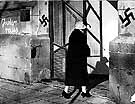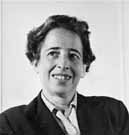
|
|
|

|

|

|

|
|
Click on an image to see a larger, more detailed picture.
|
|
|
|
|
| EPILOGUE: The Aftermath |

|
pg. 672 |

|
|
|
|
| |
 In 1959 the Cologne, Germany, synagogue was rebuilt and reconsecrated. Soon, swastikas and the words Juden raus (Jews, get out) defiled its walls.
In 1959 the Cologne, Germany, synagogue was rebuilt and reconsecrated. Soon, swastikas and the words Juden raus (Jews, get out) defiled its walls.
Photo: SYddeutscher Verlag Bilderdienst
|
 Hannah Arendt, a brilliant German-Jewish philosopher--and a former mistress of Nazi sympathizer Martin Heidegger--immigrated to the United States. She later wrote The Origins of Totalitarianism.
Hannah Arendt, a brilliant German-Jewish philosopher--and a former mistress of Nazi sympathizer Martin Heidegger--immigrated to the United States. She later wrote The Origins of Totalitarianism.
Photo: United States Holocaust Memorial Museum Photo Archive
|
|
Making his case, however, obliged Goldhagen to do more than disagree with Browning's interpretation of the archival records about Reserve Police Battalion 101. He had to show, first, that "Germans' antisemitic beliefs about Jews were the central causal agent of the Holocaust." The claim required him not only to trace the history of German antisemitism but also to document how that history involved authority and power fatal enough to account for the Holocaust's enormous destruction. In addition, Goldhagen's case hinged on demonstrating that "ordinary Germans"--not just rabidly antisemitic Nazis who had political power--either willingly engaged in the slaughter or were so willing to let it go forward that they would not have hesitated to kill if called upon to do so. In short, Goldhagen had to show that the Holocaust, contrary to Browning's "ordinary men" hypothesis, was essentially the willful act of "ordinary Germans," who were much more lethally antisemitic than previous scholarship admitted. To establish these positions, Goldhagen's book was organized around two arguments. Beginning with the history of German antisemitism, Goldhagen aimed to show how, in particular, a potentially lethal anti-Jewish racism had a powerful influence in pre-Nazi Germany. Then he focused on the actual German perpetrators of the Holocaust, studying specifically the personnel and work of killing squadrons such as Reserve Police Battalion 101. He also examined the parts played by other "ordinary Germans" in the huge system of concentration, labor, and death camps that was, as he correctly stated, "the emblematic institution of Germany during its Nazi period." To these perspectives, he added detail, as hideous as it is valuable, about a less well-known aspect of the Holocaust, namely the brutal "death marches" that took place from late 1939 until the end of World War II. First, according to Goldhagen, ordinary Germans were antisemitic. Their antisemitism entailed elimination of the Jews. Therefore, ordinary Germans were prepared to be willing executioners.
|
|

|

|

|

|
 1960: Former SS member Wernher von Braun, a leading German scientist who was instrumental in designing the V-2 terror rocket, is appointed the head of the George C. Marshall Space Flight Center in Huntsville, Alabama.
1960: Former SS member Wernher von Braun, a leading German scientist who was instrumental in designing the V-2 terror rocket, is appointed the head of the George C. Marshall Space Flight Center in Huntsville, Alabama.
|
 1960: Hitler's Zweites Buch (Hitler's Second Book) is published in Stuttgart, West Germany. The book is attributed to Adolf Hitler and is purported to be a sequel to Mein Kampf; authorship remains in doubt.
1960: Hitler's Zweites Buch (Hitler's Second Book) is published in Stuttgart, West Germany. The book is attributed to Adolf Hitler and is purported to be a sequel to Mein Kampf; authorship remains in doubt.
|
 May 23, 1960: Israeli Prime Minister David Ben-Gurion announces that Adolf Eichmann was located in Argentina by the Israeli Secret Service and has arrived in Israel to stand trial as a war criminal; See April 11-August 14, 1961.
May 23, 1960: Israeli Prime Minister David Ben-Gurion announces that Adolf Eichmann was located in Argentina by the Israeli Secret Service and has arrived in Israel to stand trial as a war criminal; See April 11-August 14, 1961.
|
|
|
|
|
| EPILOGUE: The Aftermath |

|
pg. 672 |

|
|
The Holocaust Chronicle
© 2009 Publications International, Ltd.
|
|
